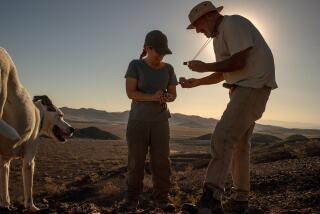Journal Stresses Fun Side of Geology
- Share via
ALBUQUERQUE, N.M. — This is geology with a twist, geology in cartoons, poems and articles with such titles as “What’s bugging the environment?” and “Geologist makes heads and talus of rock glaciers.”
Welcome to Lite Geology, a quarterly publication of the New Mexico Bureau of Mines and Mineral Resources based at New Mexico Tech in Socorro.
The publication--which runs a dozen pages and comes punched for a three-hole binder--covers contemporary geological topics aimed at an audience of teachers and regular guys rather than professional geologists.
It’s important for people to understand geology because energy and natural resources are the basis of modern industrial society, says Charles E. Chapin, state geologist and director of the bureau.
Increasingly, he believes, people are poorly informed about geologic subjects.
“People don’t think about where things come from,” Chapin says.
They may not think about the metal in their cars as having originated in the earth; they may not think about the earthly origins of their homes’ copper pipes, gypsum wallboard, oil-and-aggregate roofs or plastic pipe.
Chapin, who sits on a number of boards and commissions by virtue of his job, says people at public hearings often argue a point on emotion, not science--particularly when it comes to mining.
“The public comes at the subject totally blind. . . . Whether it’s the need for mining, whether it’s the need for oil and gas, how we get oil and gas out of the ground, how it occurs . . . earthquake hazards, how that occurs,” he says.
Lite Geology is one way to plug the education gap.
More than half the copies of the 2,800-circulation publication are used by middle and high school teachers to help students understand earth sciences. Copies also go to members of the public and New Mexico’s legislators and congressional delegation.
The magazine was created five years ago as an expansion of a teacher’s page that used to run in another, more technical Bureau of Mines publication.
The bureau found that a teacher’s page in an otherwise technical journal just didn’t work, so staff members brainstormed to “come up with something people would actually read,” Chapin says.
William C. Haneberg, the bureau’s assistant director, says people need to understand how science affects them. “It’s our responsibility to tell people in clear, plain language how we impact their lives,” he says.
Lite Geology is illustrated with maps, charts, occasional photographs and always sprightly cartoons. The cartoons are the work of Jan Thomas, a former bureau employee who works for Tech’s public information office.
The publication features articles written without the jargon of scientific journals. When technical terms do appear, they are defined in the article or in a glossary of terms included in that issue.
Each issue also contains Earth Briefs, a short look at a geologic subject such as rock glaciers; articles on current topics in earth science; sources for more earth science information and educational packets for teachers, and a main article under the heading, “Have you ever wondered . . . “
Subjects covered by the “Have you ever wondered . . . “ series include coal mining, what controls summer rainfall in the desert Southwest, how volcanologists help solve environmental problems, and why earthquakes occur.
Sometimes articles in Lite Geology get a wider reading. A recent example was an article by George S. Austin, the bureau’s senior industrial minerals geologist, in the summer 1996 issue.
Austin calculated how much “earth material”--everything from gravel to salt--that each man, woman and child in the United States uses. He divided the amount of material produced in the United States by the country’s population and concluded that each American uses 10.41 tons annually.
Austin wanted to make people realize “how much we consume in this industrial-based society. . . . We have this tremendous need for resources,” Chapin says. “We consume, but people more and more are not realizing where the things we consume come from.”
Lite Geology received numerous letters and calls asking for copies or permission to reprint the article.
Chapin says there’s been little trouble soliciting articles for Lite Geology. The problem for scientist authors comes in writing so people outside the particular technical field can understand the subject.
“Writing articles for Lite Geology is tough,” Chapin says. “It’s harder than a technical journal. . . . It surprised me; things I think are perfectly understandable are not to other people.”
More to Read
Sign up for Essential California
The most important California stories and recommendations in your inbox every morning.
You may occasionally receive promotional content from the Los Angeles Times.











